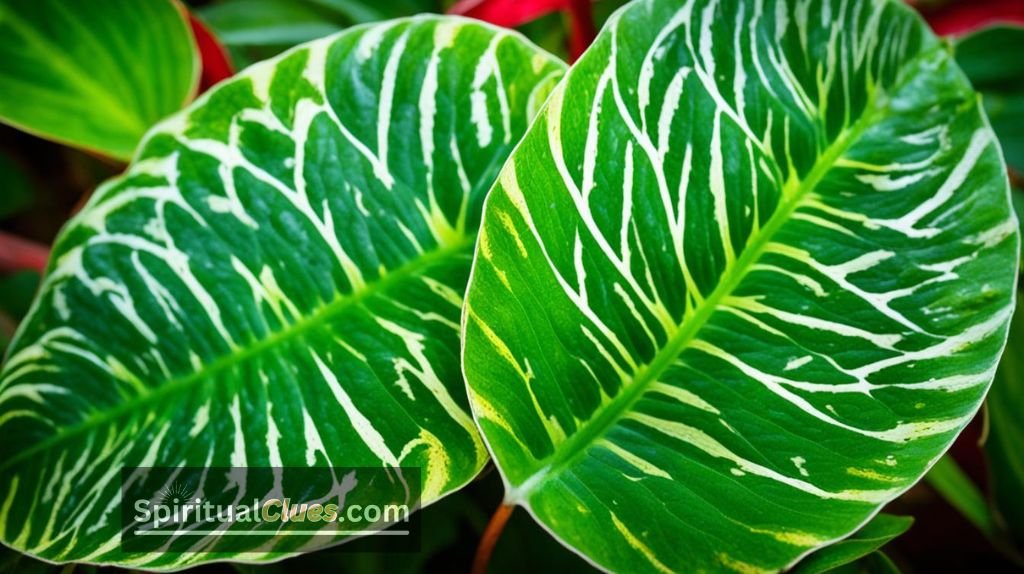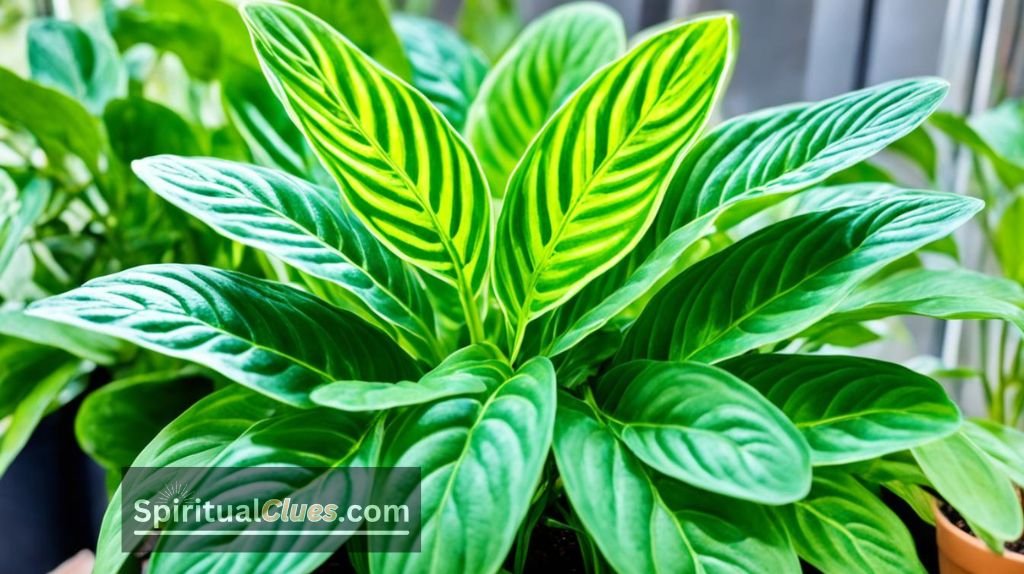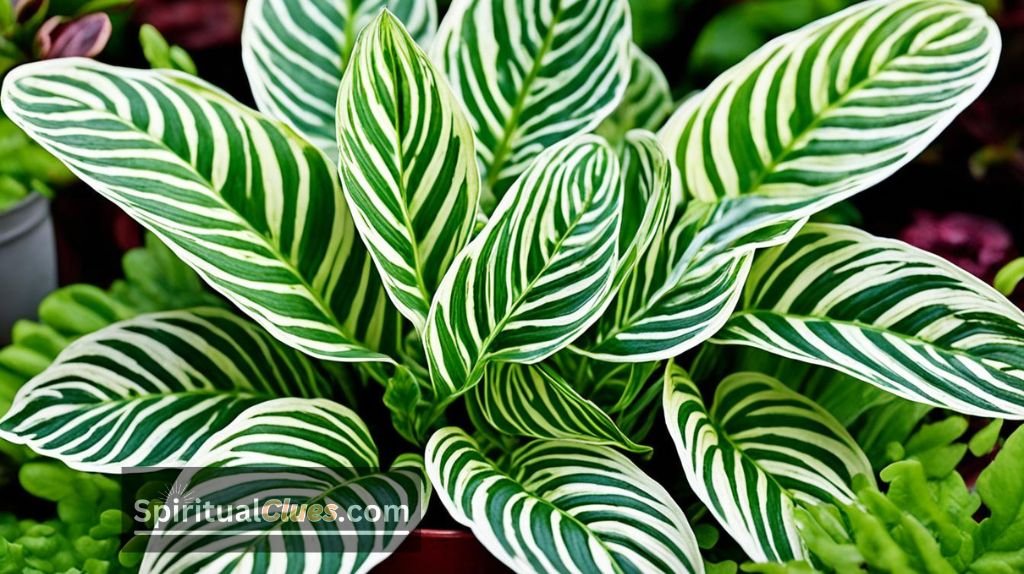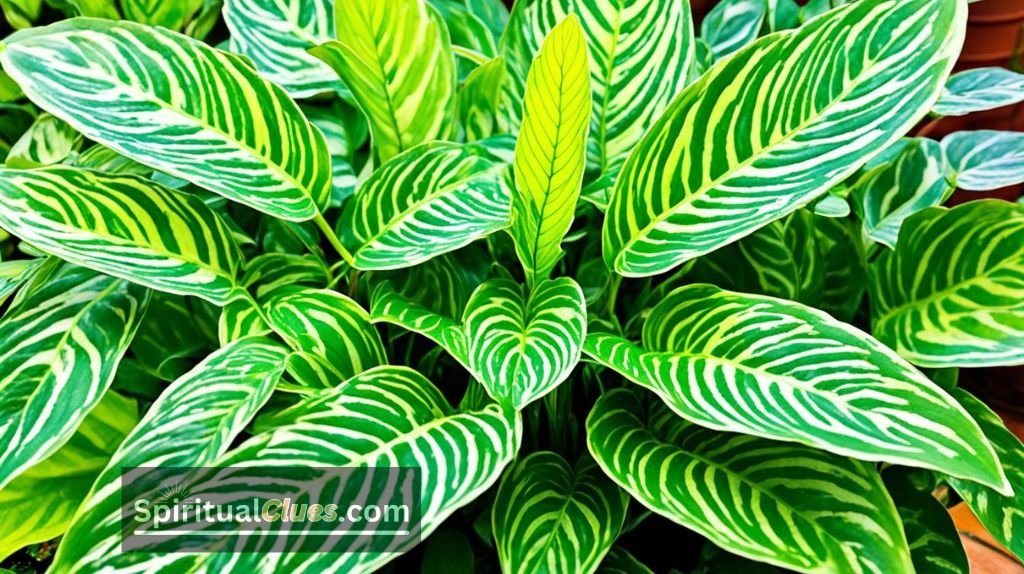- The Maranta leuconeura, or prayer plant, symbolizes perseverance, gratitude, and positive energy. Its daily leaf movements resemble hands in prayer, fostering mindfulness and spiritual connection.
- It holds cultural significance as a protector against negativity and a bringer of good luck in various traditions.
- Prayer plants are admired for their air-purifying qualities, enhancing indoor air quality by eliminating toxins.
- They thrive in bright, indirect sunlight and high humidity, making them ideal for indoor spaces.
- Incorporating prayer plants into home decor can promote a calming atmosphere and improve overall well-being.
The Maranta leuconeura, known as the prayer plant, is more than a pretty houseplant. It holds deep spiritual meaning tied to good fortune and peace. Like praying hands, this plant’s leaves fold together at night, reminding us to be mindful and seek peace.
Let’s dive into the prayer plant spiritual meaning and how it can improve our living spaces and spiritual health.
Introduction to the Prayer Plant
The prayer plant, Maranta leuconeura, is a favorite in many homes. It comes from the lush areas of Central and South America. This plant is loved for its eye-catching leaves, making it perfect for indoor spaces all year.
Overview of Maranta leuconeura
Maranta leuconeura brings a unique beauty to indoor plants. It loves warm, humid places, just like its natural home. Being a low-growing plant, it fits well in many spaces, from small corners to big plant areas.
Physical Characteristics of the Prayer Plant
The prayer plant has amazing looks. Its leaves are dark green with red or light green veins, creating a striking look. This look is pretty and shows how it has adapted to its surroundings.
One of its coolest features is how its leaves fold up at night or in dim light. It looks like hands in prayer. This makes it a standout houseplant.
The Symbolism of the Prayer Plant
The prayer plant is known for its unique behavior and beautiful leaves. It carries deep spiritual meaning in many cultures. It is seen as a source of positive energy and daily reminders of mindfulness and gratitude.
Spiritual Significance
This plant shows the beauty of spirituality with its leaf movements that look like hands in prayer. It brings a sense of peace and connection to nature. Many see it as a guardian of good fortune, used in places for peace and reflection.
Folklore and Cultural Ties
The prayer plant has a big role in many cultures. In folklore, it’s seen as a protector against negativity, bringing safety and positivity. It’s also linked with good luck, making it popular as a decoration in homes and offices.
(Maranta leuconeura) Prayer Plant Spiritual Meaning
The Prayer Plant, known as Maranta leuconeura, brings good fortune and peace. It’s a great choice for making any space better. This plant makes your home look good and adds deep spiritual meaning.

Representing Good Fortune and Tranquility
This plant is linked to positive energy and good luck. Its bright leaves remind us to live peacefully. People who have this plant may feel more balanced and find peace and wealth in their lives.
Connection to Mindfulness and Meditation
The Prayer Plant’s leaves move up in the morning and close at night. This movement reminds us to be mindful. It’s a chance to meditate and think about our thoughts and feelings. Having this plant at home helps us practice peace and reminds us to be aware of ourselves.
Understanding the Daily Movements of Prayer Plants
Prayer plants have fascinating behaviors that show how they connect with their surroundings. Their leaves move in ways that catch our eye. This movement tells us about their special way of reacting to light.
Nastic Movement Explained
The nastic movement is a cool thing about prayer plants. They move their leaves without needing a direct signal. During the day, they lift their leaves to catch sunlight. At night, they fold them back down.
This helps them survive in places with changing light. It also shows us the natural rhythms of the world.
The Connection to Daylight and Nighttime
Prayer plants respond to the day and night. Their movements act like a built-in clock, matching the environment’s day-night cycle. Watching these plants teaches us about the daily patterns that shape our lives.
Benefits of the Prayer Plant
The prayer plant is more than a symbol of spirituality. It brings health and beauty to indoor spaces. Adding this plant to your home lets you enjoy nature’s beauty and fresh air.
Air-Purifying Qualities
This plant is known for cleaning the air. It takes in harmful toxins, making the air safer to breathe. This process also brings positive energy, perfect for relaxing and being mindful.
Enhancing Home Aesthetics
The prayer plant’s leaves add beauty to any room. They highlight nature’s beauty and can be a key feature in your decor. Adding this plant boosts your home’s look and matches well with other plants, improving your interior design.
| Benefit | Description |
|---|---|
| Air Purifying | Eliminates toxins in the air for better health. |
| Positive Energy | Creates a calming atmosphere ideal for relaxation. |
| Home Aesthetics | Adds beauty and vibrancy to decor, enhancing interior themes. |
| Connection to Nature | Brings the outdoors inside, promoting mindfulness and well-being. |
Caring for Your Prayer Plant
It’s important to take good care of your prayer plant for it to stay healthy and bright. Knowing how to water, light, and keep humidity levels right can prevent common issues. This ensures your plant does well.

Watering Requirements
Keeping the soil moist is key for your prayer plant. Check the soil and water when it feels dry up to 2 inches deep. This stops overwatering, a big mistake that can cause root rot.
Using rainwater or spring water is better than tap water. Tap water might have chemicals that harm your plant.
Light and Humidity Needs
Your prayer-plant likes bright, indirect sunlight. Direct sunlight can burn its leaves. It also thrives in high humidity, aiming for 50-70%.
Consider misting your plant or using a humidifier, especially in dry places. This helps it grow well.
Common Issues and Solutions
Watch out for common problems with your prayer plant. Overwatering is a big issue, but easy to avoid by checking the soil often. If leaves turn yellow or droop, it might be too dry.
Adjust your watering and add more humidity to fix this. This will help your plant get back to health.
Different Types of Prayer Plants
The Maranta leuconeura family has many varieties of prayer-plants. Each one has its look and growing needs. This guide will cover three popular types: Lemon Lime, Rabbit’s Foot, and Black Prayer Plant. Learning about their unique leaves can make your garden and home look better.
Lemon Lime Prayer Plant (M. leuconeura)
The Lemon Lime Prayer Plant is known for its bright colors. It has yellow-green leaves that do well in bright, indirect light. This plant adds a fresh touch to any room.
Rabbit’s Foot Prayer Plant (M. leuconeura var. Kerchoveana)
The Rabbit’s Foot Prayer Plant is special because of its trailing vines. Its leaves fold uniquely and feel soft. It’s great for hanging planters, creating a beautiful flow that adds creativity to your space.
Black Prayer Plant and Others
The Black Prayer Plant is famous for its dark leaves with silver veins. It’s often the centerpiece of home décor, adding a deep contrast to lighter colors. There are many other prayer plants, each with its special look and feel.
Incorporating Prayer Plants into Your Home
Prayer plants make your home look better and help create a positive spiritual feel. It’s important to pick the right spot for your prayer plant to get the most benefits. This section will talk about the best places and how to use feng shui to make your home better.
Choosing the Right Location
Choosing the right spot for your prayer plant is key to its growth and how it affects your space. Go for areas with soft sunlight, as strong light can harm the leaves. Here are some great spots:
- Near east-facing windows to catch the morning light.
- Away from drafts and heat sources like radiators or vents.
- Places with moderate humidity, like bathrooms or kitchens.
Uses in Feng Shui
Using feng shui with your prayer plant can boost positive energy in your home. Here’s how to use them according to feng shui:
- Place in the East direction for new beginnings and growth.
- Put them in living areas for peace and calm.
- Use in spots related to personal growth or career for motivation.
By choosing the right spot and following feng shui, prayer plants become great for creating a positive vibe and calm in your home.

FAQs on the (Maranta leuconeura) Prayer Plant Spiritual Meaning
What is the spiritual meaning of the Prayer Plant (Maranta leuconeura)?
The Prayer Plant, also known as Maranta leuconeura, is believed to symbolize perseverance, gratitude, and positive energy. Its unique daily leaf movements, which resemble hands in prayer, foster a deeper meditative and spiritual connection.
Why is the Prayer Plant called so?
The Prayer Plant is named for its fascinating leaf movements. The leaves of the plant fold upward in the evening, resembling hands clasped in prayer, and open flat during the day. This daily movement is thought to symbolize devotion and mindfulness.
What are the benefits of having a Prayer Plant in your home?
Prayer Plants are also believed to bring good luck and positive energy to your home. Their lush, green leaves and vibrant foliage add beauty and tranquility to any space, while also improving indoor air quality by filtering out pollutants.
How do you care for a Prayer Plant?
Prayer Plants thrive in moist soil and prefer bright, indirect sunlight. They should be watered regularly, keeping the soil evenly moist but not waterlogged. During the growing season, it’s beneficial to prune and repot the plant to encourage healthy growth.
What is the significance of the leaves of the Prayer Plant?
The dark green leaves of the Prayer Plant, with their distinctive patterns and movements, symbolize resilience and adaptability. They work tirelessly to align with the plant’s natural rhythms, representing harmony and balance in one’s life.
What are the top benefits of having a Prayer Plant?
Aside from their spiritual symbolism, Prayer Plants are low-maintenance and add a touch of lush greenery to your home. They are known for their ability to thrive in low light and purify indoor air, making them a popular choice among plant enthusiasts.
Who discovered the Prayer Plant and its significance?
The Prayer Plant is named after Bartolomeo Maranta, an Italian physician and botanist from the 16th century. His work in the study of plant symbolism and benefits contributed to the plant’s recognition and reverence.
How do Prayer Plants relate to other plants in the Marantaceae family?
The Prayer Plant belongs to the Marantaceae family, a genus of flowering plants that includes Calatheas and other ornamental plants. This family is known for its vibrant foliage and unique leaf movements, making them a beacon of beauty and mystique in the plant world.
Related Articles You May Also Like:
- (Tradescantia Pallida) Purple Heart Plant Spiritual Meaning and Symbolism
- The Surprising Snake Plant Spiritual Meaning You Won’t Believe!
- Chinese Money Plant Spiritual Meaning: Pilea Peperomioides
Conclusion
The Maranta leuconeura, or prayer plant, is more than just a pretty houseplant. It brings peace, and luck, and helps with spiritual growth. Adding it to your home makes your space better and connects you with a meaningful tradition.
Looking after the prayer plant deepens your bond with nature. It’s a way to practice mindfulness, bringing peace and harmony into your home. This helps improve your mental health and makes your living space more welcoming.
The prayer plant has many benefits, like cleaning the air and making your home look beautiful. By bringing this plant into your life, you’ll find more joy and peace. It’s a way to make your home and mind a better place. Let the prayer plant be a part of your daily life for its beauty and deep meaning.


